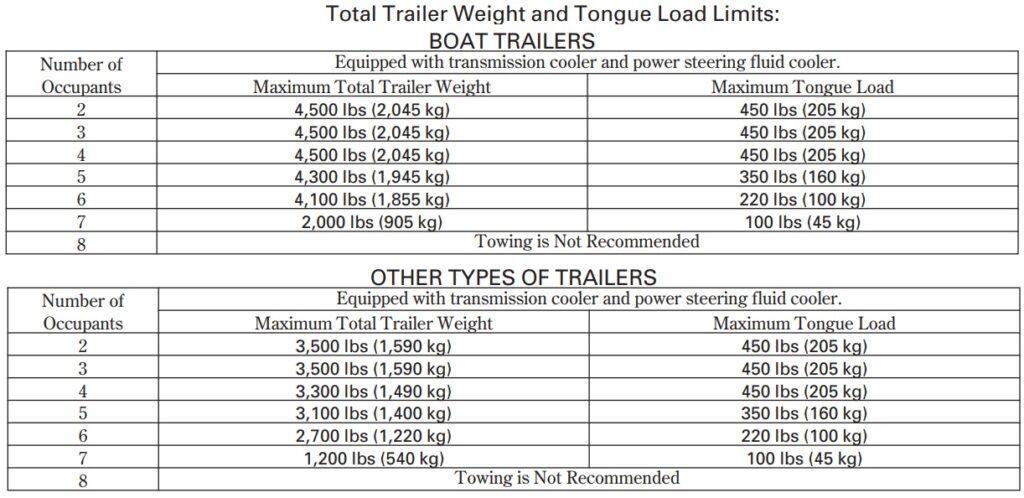What Is The Tow Capacity Of A Honda Pilot

The Honda Pilot, a mainstay in the mid-size SUV segment, is a popular choice for families seeking a versatile and reliable vehicle. A key consideration for many buyers is its towing capacity. This article provides an in-depth look at the Honda Pilot's towing capabilities, exploring the engineering behind it, comparing it to competitors, and discussing its real-world performance and reliability.
Honda Pilot Towing Capacity: Technical Specifications
The 2023 Honda Pilot, the beginning of its fourth generation, boasts a maximum towing capacity of 5,000 pounds when properly equipped with the available trailer hitch and wiring harness. This applies specifically to models with all-wheel drive (AWD). Front-wheel drive (FWD) models typically have a lower towing capacity, around 3,500 pounds. Earlier generations of the Pilot offer varying towing capacities, generally ranging from 3,500 to 5,000 pounds depending on the model year and drivetrain.
The Pilot's towing prowess stems from its robust powertrain. The standard engine is a 3.5-liter V6, producing around 285 horsepower and 262 lb-ft of torque. This engine is paired with a 10-speed automatic transmission, which provides smooth and efficient power delivery. The AWD system plays a crucial role in maximizing towing capacity, distributing torque to all four wheels for enhanced traction and stability. The vehicle's frame and suspension are also designed to handle the stresses associated with towing.
Engineering Choices and Towing Performance
Honda's engineering approach emphasizes reliability and longevity. The V6 engine, known for its durability, features a relatively low compression ratio, reducing stress on internal components. The 10-speed transmission is designed for optimized gear ratios, aiding in both fuel efficiency and towing performance. Furthermore, the independent front and rear suspension systems contribute to a comfortable ride even when towing, absorbing bumps and maintaining stability.
The Pilot's *Vehicle Stability Assist* (VSA) system includes trailer stability assist, which monitors trailer sway and applies individual brakes to counteract unwanted movement. This system significantly enhances safety when towing, especially in windy conditions or during sudden maneuvers.
In real-world performance, the Pilot provides adequate power for towing smaller boats, campers, and utility trailers. However, it's crucial to stay within the specified weight limits. Overloading the vehicle can lead to reduced braking performance, compromised handling, and potential damage to the powertrain and suspension.
Comparison with Alternatives
The mid-size SUV market is highly competitive, and several alternatives to the Honda Pilot offer comparable or superior towing capabilities. The Toyota 4Runner, for example, consistently offers a 5,000-pound towing capacity across all trims, making it a strong contender. The Ford Explorer, particularly with its available EcoBoost engines, can tow up to 5,600 pounds. The Jeep Grand Cherokee, depending on the engine, can tow upwards of 6,200 pounds.
Pros of the Honda Pilot for Towing:
- Reliable V6 engine.
- Smooth 10-speed transmission.
- Trailer Stability Assist system.
- Reputation for longevity and low maintenance costs.
Cons of the Honda Pilot for Towing:
- Lower towing capacity compared to some competitors.
- FWD models have significantly reduced towing capacity.
- Some users report feeling the strain when towing near the maximum capacity on inclines.
Reliability Aspects and Maintenance Tips
The Honda Pilot is generally considered a reliable vehicle, with strong scores in various reliability surveys. However, proper maintenance is crucial to ensure long-term towing performance. Regular oil changes, transmission fluid flushes, and brake inspections are essential. When towing frequently, it's advisable to shorten the maintenance intervals to account for the increased stress on the vehicle's components.
Specifically, pay close attention to the transmission. Towing puts significant strain on the transmission, generating heat. Consider installing an auxiliary transmission cooler, especially if you plan to tow regularly in hot climates. Also, inspect the trailer hitch and wiring harness for damage and corrosion. Ensure that the trailer lights and brakes are functioning correctly before each trip.
Future Trends and the Automotive Industry
The automotive industry is rapidly evolving, with electrification and autonomous driving becoming increasingly prominent. Future generations of the Honda Pilot are likely to incorporate hybrid or fully electric powertrains. While electric vehicles offer instant torque and impressive towing capabilities, range limitations and charging infrastructure remain challenges. As battery technology improves and charging networks expand, electric SUVs will become a more viable option for towing.
Furthermore, advancements in autonomous driving technology could lead to more sophisticated towing systems that automatically adjust vehicle settings and provide enhanced stability and control. Sensors and cameras could be used to monitor trailer sway and automatically correct for it, making towing safer and easier.
Looking ahead, the key to successful towing in the future will lie in the seamless integration of powertrain technology, advanced driver-assistance systems, and smart trailering solutions. Honda, like other automakers, will need to adapt to these changing trends to maintain its position in the competitive mid-size SUV market. The future may bring self-leveling suspensions, integrated trailer brake controllers as standard features, and even over-the-air updates to optimize towing performance based on real-time conditions.
